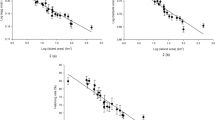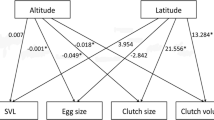Abstract
The adaptive function of trophic egg-laying is generally regarded as extended parental investment to the offspring. However, the evolutionary factors promoting trophic egg-laying are still unclear, because the amount of maternal investment per offspring should be ideally equal between smaller offspring with trophic eggs and larger offspring without any additional investment. Several authors have suggested that trophic egg-laying should evolve only when egg size is constrained, but this hypothesis has not been evaluated. We investigated the evolutionary mechanisms of trophic egg-laying by two different approaches. First, we evaluated morphological constraints on egg size in two sibling ladybird species, Harmonia axyridis, which is known to produce trophic eggs, and H. yedoensis. Second, we theoretically predicted the optimal proportion of trophic eggs to total eggs and egg size in relation to environmental heterogeneity, predictability of environmental quality, and investment efficiency of trophic egg consumption. The intra- and interspecific morphological comparisons suggest that morphological constraints on the evolutionary determination of egg size are weak at best in the two ladybird species. Moreover, we theoretically showed that small egg size and trophic egg-laying are favoured in heterogeneous environments when mothers cannot adjust egg size plastically. We also showed that even a small reduction in investment efficiency makes a trophic egg strategy unlikely, despite relatively high environmental predictability. We conclude that trophic egg provisioning may be a flexible maternal adaptation to a highly heterogeneous environment rather than a response to a morphological constraint on egg size.






Similar content being viewed by others

References
Alexander RD (1974) The evolution of social behavior. Annu Rev Ecol Syst 5:325–383
Bauerfeind SS, Fischer K (2008) Maternal body size as a morphological constraint on egg size and fecundity in butterflies. Basic Appl Ecol 9:443–451
Baur B (1988) Repeated mating and female fecundity in the simultaneously hermaphroditic land snail Arianta arbustorum. Int J Invertebr Reprod Dev 14:197–204
Baur B (1990) Possible benefits of egg cannibalism in the land snail Arianta arbustorum (L.). Funct Ecol 4:679–684
Baur B, Raboud C (1988) Life history of the land snail Arianta arbustorum along an altitudinal gradient. J Anim Ecol 57:71–87
Berrigan D, Scheiner SM (2004) Modeling the evolution of phenotypic plasticity. In: DeWitt TJ, Scheiner SM (eds) Phenotypic plasticity: functional and conceptual approaches. Oxford University Press, Oxford, pp 82–97
Christians JK (2002) Avian egg size: variation within species and inflexibility within individuals. Biol Rev 77:1–26
Clark PJ, Ewert MA, Nelson CE (2001) Physical apertures as constraints on egg size and shape in the common musk turtle, Sternotherus odoratus. Funct Ecol 15:70–77
Congdon JD, Gibbons JW (1987) Morphological constraint on egg size: a challenge to optimal egg size theory? Proc Natl Acad Sci USA 84:4145–4147
Crean AJ, Marshall DJ (2009) Coping with environmental uncertainty: dynamic bet hedging as a maternal effect. Philos Trans R Soc B 364:1087–1096
Crespi BJ (1992) Cannibalism and trophic egg in subsocial and eusocial insects. In: Elgar MA, Crespi BJ (eds) Cannibalism: ecology and evolution among diverse taxa. Oxford University Press, Oxford, pp 176–213
Crump ML (1981) Variation in propagule size as a function of environmental uncertainty for tree frogs. Am Nat 117:724–737
Dall SRX, Giraldeau LA, Olsson O, McNamara JM, Stephens DW (2005) Information and its use by animals in evolutionary ecology. Trends Ecol Evol 20:187–193
Dixon AFG (1998) Aphid ecology. Chapman and Hall, London
Dixon AFG (2000) Insect predator–prey dynamics: ladybird beetles and biological control. Cambridge University Press, Cambridge
Dixon AFG, Guo Y (1993) Egg and cluster size in ladybird beetles (Coleoptera: Coccinellidae): the direct and indirect effects of aphid abundance. Eur J Entomol 90:457–463
Einum S, Fleming IA (2004) Environmental unpredictability and offspring size: conservative versus diversified bet-hedging. Evol Ecol Res 6:443–455
Elgar MA, Crespi BJ (1992) Cannibalism: ecology and evolution among diverse taxa. Oxford University Press, Oxford
Fischer K, Zwaan BJ, Brakefield PM (2002) How does egg size relate to body size in butterflies? Oecologia 131:375–379
Fischer B, Taborsky B, Kokko H (2011) How to balance the offspring quality–quantity tradeoff when environmental cues are unreliable. Oikos 120:258–270
Fox CW, Czesak ME (2000) Evolutionary ecology of progeny size in arthropods. Annu Rev Entomol 45:341–369
Fox CW, Thakar MS, Mousseau TA (1997) Egg size plasticity in a seed beetle: an adaptive maternal effect. Am Nat 149:149–163
Gibson RC, Buley KR (2004) Maternal care and obligatory oophagy in Leptodactylus fallax: a new reproductive mode in frogs. Copeia 2004:128–135
Gilbert F (1990) Size, phylogeny and life-history in the evolution of feeding specialization in insect predators. In: Gilbert F (ed) Insect life cycles: genetics, evolution and co-ordination. Springer, New York, pp 101–124
Gobin B, Peeters C, Billen J (1998) Production of trophic eggs by virgin workers in the ponerine ant Gnamptogenys menadensis. Physiol Entomol 23:329–336
Hemptinne JL, Dixon AFG, Coffin J (1992) Attack strategy of ladybird beetles (Coccinellidae): factors shaping their numerical response. Oecologia 90:238–245
Hölldobler B, Wilson EO (1990) The ants. Harvard University Press, Massachusetts
Ji X, Du WG, Li H, Lin LH (2006) Experimentally reducing clutch size reveals a fixed upper limit to egg size in snakes, evidence from the king ratsnake, Elaphe carinata. Comp Biochem Physiol A 144:474–478
Kam YC, Lin CF, Lin YS, Tsal YF (1998) Density effects of oophagous tadpoles of Chirixalus eiffingeri (Anura: Rhacophoridae): importance of maternal brood care. Herpetologica 54:425–433
Kawai A (1978) Sibling cannibalism in the first instar larvae of Harmonia axyridis Pallas (Coleoptera: Coccinelidae). Kontyû 46:14–19
Kawecki TJ (1995) Adaptive plasticity of egg size in response to competition in the cowpea weevil, Callosobruchus maculatus (Coleoptera: Bruchidae). Oecologia 102:81–85
Kudo S, Nakahira T (2004) Effects of trophic-eggs on offspring performance and rivalry in a sub-social bug. Oikos 107:28–35
Kudo S, Nakahira T (2005) Trophic-egg production in a subsocial bug: adaptive plasticity in response to resource conditions. Oikos 111:459–464
Kudo S, Nakahira T, Saito Y (2006) Morphology of trophic eggs and ovarian dynamics in the subsocial bug Adomerus triguttulus (Heteroptera: Cydnidae). Can J Zool 84:723–728
Leather SR, Burnand AC (1987) Factors affecting life-history parameters of the pine beauty moth, Panolis flammea (D & S): the hidden costs of reproduction. Funct Ecol 1:331–338
Majerus TMO, Majerus MEN, Knowles B, Wheeler J, Bertrand D, Kuznetzov VN, Ueno H, Hurst GDD (1998) Extreme variation in the prevalence of inherited male-killing microorganisms between three populations of Harmonia axyridis (Coleoptera: Coccinellidae). Heredity 81:683–691
Marshall DJ, Uller T (2007) When is a maternal effect adaptive? Oikos 116:1957–1963
Marshall DJ, Bonduriansky R, Bussière LF (2008) Offspring size variation within broods as a bet-hedging strategy in unpredictable environments. Ecology 89:2506–2517
McGinley MA, Temme DH, Geber MA (1987) Parental investment in offspring in variable environments: theoretical and empirical considerations. Am Nat 130:370–398
Mizumoto M, Nakasuji F (2007) Egg size manipulation in the migrant skipper Parnara guttata guttata (Lepdoptera: Hesperiidae), in response to different host plants. Popul Ecol 49:135–140
Mock DW, Parker GA (1997) The evolution of sibling rivalry. Oxford University Press, Oxford
Nomakuchi S, Filippi L, Hironaka M (2001) Nymphal occurrence pattern and predation risk in the subsocial shield bug, Parastrachia japonensis (Heteroptera: Cydnidae). Appl Entomol Zool 36:209–212
Noriyuki S, Kishi S, Nishida T (2010) Seasonal variation of egg size and shape in Ypthima multistriata (Lepidoptera: Satyridae) in relation to maternal body size as a morphological constraint. Ann Entomol Soc Am 103:580–584
Noriyuki S, Osawa N, Nishida T (2011) Prey capture performance in hatchlings of two sibling Harmonia ladybird species in relation to maternal investment through sibling cannibalism. Ecol Entomol 36:282–289
Osawa N (1989) Sibling and non-sibling cannibalism by larvae of a lady beetle Harmonia axyridis Pallas (Coleoptera: Coccinellidae) in the field. Res Popul Ecol 31:153–160
Osawa N (1992a) Sibling cannibalism in the ladybird beetle Harmonia axyridis Pallas: fitness consequences for mothers and offspring. Res Popul Ecol 34:45–55
Osawa N (1992b) A life table of the ladybird beetle Harmonia axyridis Pallas (Coleoptera, Coccinellidae) in relation to the aphid abundance. Jap J Entomol 60:575–579
Osawa N (2000) Population field studies on the aphidophagous ladybird beetle Harmonia axyridis (Coleoptera: Coccinellidae): resource tracking and population characteristics. Popul Ecol 42:115–127
Osawa N, Ohashi K (2008) Sympatric coexistence of sibling species Harmonia yedoensis and H. axyridis (Coleoptera: Coccinellidae) and the roles of maternal investment through egg and sibling cannibalism. Eur J Entomol 105:445–454
Osawa N, Yoshinaga A (2009) The presence of micropyles in the shells of developing and undeveloped eggs of the ladybird beetle Harmonia axyridis (Coleoptera: Coccinellidae). Eur J Entomol 106:607–610
Parker GA, Begon M (1986) Optimal egg size and clutch size: effects of environment and maternal phenotype. Am Nat 128:573–592
Parker GA, Royle NJ, Hartley IR (2002) Intrafamilial conflict and parental investment: a synthesis. Philos Trans R Soc B 357:295–307
Perry JC, Roitberg BD (2005a) Ladybird mothers mitigate offspring starvation risk by laying trophic eggs. Behav Ecol Sociobiol 58:578–586
Perry JC, Roitberg BD (2005b) Games among cannibals: competition to cannibalize and parent-offspring conflict lead to increased sibling cannibalism. J Evol Biol 18:1523–1533
Perry JC, Roitberg BD (2006) Trophic egg laying: hypotheses and tests. Oikos 112:706–714
Polis GA (1984) Intraspecific predation and “infant killing” among invertebrates. In: Hausfater G, Hrdy SB (eds) Infanticide: comparative and evolutionary perspectives. Aldine De Gruyter, Berlin, pp 87–104
Rollinson N, Brooks R (2008) Optimal offspring provisioning when egg size is “constrained”: a case study with the painted turtle Chrysemys picta. Oikos 117:144–151
Sakagami SF (1982) Stingless bees. In: Hermann HR (ed) Social insects, vol 3. Academic Press, Massachusetts, pp 362–424
Sakai S, Harada Y (2001) Why do large mothers produce large offspring? Theory and a test. Am Nat 157:348–359
Sasaji H (1998) Natural history of the ladybirds. University of Tokyo Press, Tokyo (in Japanese)
Sinervo B, Licht P (1991) Hormonal and physiological control of clutch size, egg size, and egg shape in side-blotched lizards (Uta stansburiana): constraints on the evolution of lizard life histories. J Exp Zool 257:252–264
Smith CC, Fretwell SD (1974) The optimal balance between size and number of offspring. Am Nat 108:499–506
Soares AO, Coderre D, Schanderl H (2001) Fitness of two phenotypes of Harmonia axyridis (Coleoptera: Coccinellidae). Eur J Entomol 98:287–293
Sokal RR, Rohlf FJ (1995) Biometry, 3rd edn. Freeman, New York
Stewart LA, Hemptinne JL, Dixon AFG (1991a) Reproductive tactics of ladybird beetles: relationship between egg size, ovariole number and developmental time. Funct Ecol 5:380–385
Stewart LA, Dixon AFG, Ruzicka Z, Iperti G (1991b) Clutch and egg size in ladybird beetles. Entomophaga 36:93–97
Takakura K (2004) Variation in egg size within and among generations of the bean weevil, Bruchidius dorsalis (Coleoptera, Bruchidae): effects of host plant quality and paternal nutritional investment. Ann Entomol Soc Am 97:346–352
Trivers RL (1974) Parent-offspring conflict. Am Zool 14:249–264
Wedell N, Gage MJG, Parker GA (2002) Sperm competition, male prudence and sperm-limited females. Trends Ecol Evol 17:313–320
Werner EE, Gilliam JF (1984) The ontogenetic niche and species interactions in size structures populations. Annu Rev Ecol Syst 15:393–425
Acknowledgments
We thank T. Nishida and N. Baba for valuable discussions, Y. Harada for advice on mathematical analyses, S. Seiter for improving English version, and M. Tokeshi and J.-Y. Ide for comments on the manuscript. We are grateful to the staff at the Botanical Garden of Kyoto University for permission to collect ladybirds. This study was supported by a Research Fellowship for Young Scientists from the Japan Society for the Promotion of Science to S. Noriyuki and K. Kawatsu, and a Grant-in-Aid for Scientific Research (Ministry of Education, Culture, Sports, Science and Technology of Japan; No. 20405047) to N. Osawa.
Author information
Authors and Affiliations
Corresponding author
Rights and permissions
About this article
Cite this article
Noriyuki, S., Kawatsu, K. & Osawa, N. Factors promoting maternal trophic egg provisioning in non-eusocial animals. Popul Ecol 54, 455–465 (2012). https://doi.org/10.1007/s10144-012-0317-6
Received:
Accepted:
Published:
Issue Date:
DOI: https://doi.org/10.1007/s10144-012-0317-6



